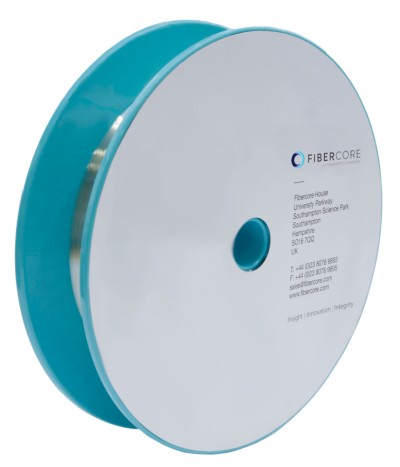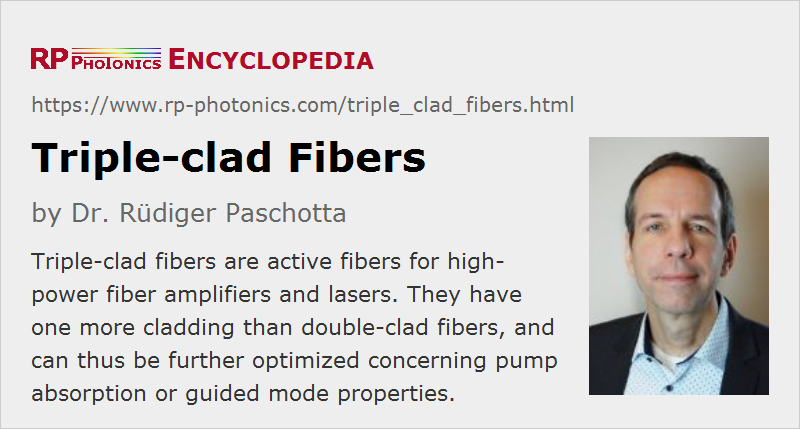Triple-clad Fibers
Definition: optical fibers having three claddings
More general terms: active fibers, rare-earth-doped fibers
German: Dreifach-Cladding-Fasern, Fasern mit drei Claddings
Category:  fiber optics and waveguides
fiber optics and waveguides
Author: Dr. Rüdiger Paschotta
Cite the article using its DOI: https://doi.org/10.61835/t1d
Get citation code: Endnote (RIS) BibTex plain textHTML
The simplest type of active fibers for use in fiber amplifiers and lasers are rare-earth-doped fibers where the pump light is directly injected into the fiber core. A more refined design is that of double-clad fibers, where there is an additional undoped fiber cladding into which the pump radiation is launched; this approach allows for far higher output powers of active fiber devices. Going one step further to triple-clad fibers, i.e., introducing one more cladding region, one may achieve additional advantages, although the basic operation principles are the same as for double-clad fibers.
Fibers with All-glass Double-clad Structure
Double-clad fibers are often made such that the pump cladding is only surrounded by a polymer coating with sufficiently low refractive index such that a sufficiently high numerical aperture of the pump cladding is achieved. Particularly for operation at high power levels with reliable durability, however, it is desirable to have an all-glass waveguide, where the optical field does not get into contact with the polymeric coating, and the fiber would actually work as well without that coating. This can be achieved by surrounding the pump cladding with another layer of optical glass, having a lower refractive index. For example, a pure-silica pump cladding can be surrounded by fluorine-doped (index-depressed) glass.
Such a triple-clad design comes with additional options:

- It is then possible to make the pump cladding substantially smaller in diameter, such that the core/cladding area ratio becomes larger. That way, one achieves a stronger coupling of the pump light to the fiber core. That leads to efficient pump absorption in a shorter length of the fiber and to a higher degree of the dopant excitation for the same level of pump power. Of course, the pump source then needs to have a correspondingly better beam quality (higher brightness), as the reduced pump cladding size and the typically lower numerical aperture (see below) imply a reduced number of guided modes of the pump cladding.
- One can also more easily modify the geometric shape of the pump cladding. For example, one may use an elliptical, octagonal or rectangular shape (see Figure 1), while the total cross-section of the glass fiber remains a circle. That circular shape is better for fusion splicing of fibers with consistently low insertion loss.
Unfortunately, the achievable refractive index contrast between the inner and outer cladding is smaller if both claddings consist of a glass; polymers can be produced with significantly lower refractive index. Therefore, the numerical aperture of the pump cladding is smaller for such fibers (limited to roughly 0.28), which implies that the beam quality of the pump radiation needs to be correspondingly better. However, if some of the pump radiation has angular components beyond that NA limit, it may still be guided by the outer polymer cladding; it is just that this part of the pump power is then spread over a larger area and has a correspondingly weaker pump absorption.
Triple-clad designs with relatively small pump cladding can also be used for Raman lasers [4], where it is important to reach high enough pump intensities.
Optimizing the Mode Structure
In some cases, one fabricates another cladding of relatively small diameter around the fiber core [1, 2]. For example, that first cladding may be doped with germania for a somewhat increased refractive index, so that the refractive index difference to the active fiber core is reduced; this helps to achieve a large mode area. The combination of core and first cladding may then actually also be regarded just as a larger fiber core with confined active doping.
Particularly in cases where a high level of rare-earth doping of the fiber core is required, it would be more difficult to achieve the small refractive index contrast without that first cladding. Another aspect is that confining the active dopant to the central region (not including the first cladding) one achieves an often desirable gain advantage for the fundamental guided mode. Note that the guided modes of the region including both the doped core and the first cladding substantially extend into the latter.
The second cladding may consist of pure silica, having a still lower refractive index; this is used as the pump cladding, i.e., for injecting the pump radiation. Around the second cladding, there is then a polymeric coating, which may be counted as the third cladding, even though it has no optical function. Its numerical aperture can be quite large.
The additional degrees of freedom (diameter and refractive index of the first cladding) can also be used to minimize bend losses or to utilize bend losses for higher-order mode suppression.
More to Learn
Encyclopedia articles:
Suppliers
The RP Photonics Buyer's Guide contains seven suppliers for triple-clad fibers. Among them:


Fibercore
Fibercore’s triple-clad doped fibers are designed for fiber lasers and high power CATV and telecoms amplifiers. Their unique triple cladding structure is designed to encapsulate the octagonal mode mixing pump guide within a circular outer cladding, enabling lower splice losses and lower splice variability associated with fibers with octagonal outer regions. This triple cladding structure also gives an additional mode confinement structure to reduce the amount of pump light at the cladding-coating interface to aid coating reliability.
Bibliography
| [1] | A. Croteau and J. Lauzon, “Triple-clad rare-earth doped optical fiber and applications”, US Patent # 6, 941, 053 (2005) |
| [2] | A. Croteau et al., “Bending-insensitive, highly Yb-doped LMA triple clad fiber for nearly diffraction-limited laser output”, Proc. SPIE 6101, 61010G-1 (2006); https://doi.org/10.1117/12.674317 |
| [3] | C. Gaida et al., “Triple-clad large-pitch fibers for compact high-power pulsed fiber laser systems”, Opt. Lett. 39 (2), 209 (2014); https://doi.org/10.1364/OL.39.000209 |
| [4] | Y. Shamir et al., “250 W clad pumped Raman all-fiber laser with brightness enhancement”, Opt. Lett. 43 (4), 711 (2018); https://doi.org/10.1364/OL.43.000711 |
| [5] | Y. Feng et al., “Pump absorption, laser amplification, and effective length in double-clad ytterbium-doped fibers with small area ratio”, Opt. Express 27 (19), 26821 (2019); https://doi.org/10.1364/OE.27.026821 |
| [6] | S. K. Kalyoncu, B. Mete and A. Yenıay, “Diode-pumped triple-clad fiber MOPA with an output power scaling up to 4.67 kW”, Opt. Lett. 45 (7), 1870 (2020); https://doi.org/10.1364/OL.387230 |
Questions and Comments from Users
Here you can submit questions and comments. As far as they get accepted by the author, they will appear above this paragraph together with the author’s answer. The author will decide on acceptance based on certain criteria. Essentially, the issue must be of sufficiently broad interest.
Please do not enter personal data here; we would otherwise delete it soon. (See also our privacy declaration.) If you wish to receive personal feedback or consultancy from the author, please contact him, e.g. via e-mail.
By submitting the information, you give your consent to the potential publication of your inputs on our website according to our rules. (If you later retract your consent, we will delete those inputs.) As your inputs are first reviewed by the author, they may be published with some delay.



Connect and share this with your network:
Follow our specific LinkedIn pages for more insights and updates: